Section IV of the booklet “50 years of the Amersham Society” covers the following chapters: The Society becomes a separate organisation · The Society moves forward in the new Millennium · The overall appearance of the town · Monitoring planning activities · Caring for the environment.
The Society becomes a separate organisation
In 1999 the Museum was going through a period of considerable change including application for formal registration and planning the extension for a curator’s office and additional exhibition space. Museum (Amersham Historic Buildings Trust) matters had up until this time been dealt with within the Amersham Society Committee, but with these developments and particularly the need for major fund raising, the Amersham Society Committee and Amersham Historic Buildings Trust Council agreed that the management arrangements should be more formalised and meetings should be documented separately. By the following year the Museum workload had increased further, including the re-introduction of the ‘Friends of the Museum’.
From this time, meetings of the Society Committee and Amersham Historic Buildings Trust Council took place separately, but a report on Museum activities was given at Amersham Society Committee meetings. Communication to Society members has continued from that time by inclusion of a section in the Society Newsletter on Museum matters.
The early objective in the Society Constitution’…. to establish a permanent Museum in Amersham’ was no longer relevant in the year 2000 and the revised Constitution of the Amersham Society had the following objectives:
(a) To preserve and improve the character and amenities of the old town of Amersham.
(b) To promote standards of architecture, conservation, planning, design, maintenance and use of buildings and infrastructure compatible with the character and quality of life in and/or affecting the old town of Amersham.
(c) To organise lectures for the enlightenment of members and to encourage general support of the Society.
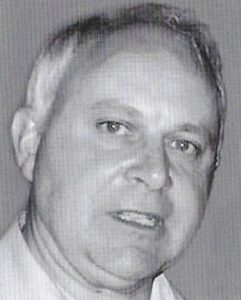
At the Amersham Society Annual General Meeting in October 1999 Jean Archer retired as Chairman; Harry Morton was elected to this position and Anthony del Tufo as Chairman of Amersham Historic Buildings Trust leading the changes in Museum activities. Harry Morton resigned in 2002 for health reasons and Anthony del Tufo took over as Acting Chairman of the Society until 2004 when Martin Brooks accepted this position. The Amersham Historic Buildings Trust became legally known as Amersham Museum Limited in 2005.
At the Annual General Meeting in November 2005, a presentation of an engraved paperweight was made to Anthony del Tufo in recognition of 30 years of service on the Committee of the Amersham Society and all the work he had done for the town over such a long period; he continued to chair the Museum Council.
In August 2003, Tony Woodcock a long-standing member of the Society and Founder Friend of the Museum, died, leaving a substantial legacy to Amersham Museum. As a result of his generosity, the Museum was able to appoint Jane Bowen as Curator and as its first paid member of staff. Under Jane’s expert guidance, assisted as always by many skilled volunteers, the Museum has produced a five year plan, the first results of which could be seen when the Museum re-opened at Easter 2006, after a complete re-display of the ground floor exhibits, including new cabinets, panels, lighting and shop area.
The Society moves forward in the new Millennium
In 2004, led by the new chairman, Martin Brooks, discussions were held with Tony Westhead and the Committee of the Amersham Old Town Residents Association with a view to merger. The matter of traffic through the Town has always been a difficult problem to resolve, and the Residents Association had been set up to champion the issues of the High Street, in conflict with the Society, who had felt the need to reflect a wider spectrum of opinion. Despite minor acrimony at the time, the interests of the two organisations were very similar and many residents belonged to both. The merger of the two Committees was helpful and the Old Town Residents generously allowed the joint association to be known as the Amersham Society.
The overall appearance of the town
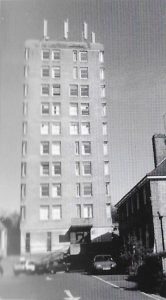
Under Anthony del Tufo’s wise guidance, the Society has sought over the years to address three major eyesores in Amersham, the Nurses’ home, the Gasometers and the Brazil’s factory and indeed all are now removed, although the replacement of the factory by the Tesco supermarket was not what the Society had in mind.
The Society has always sought to remove garish and unsightly signs and lighting in particular. It was a relief to see the Swan retain its traditional elegant bird on its sign, rather than be known as the ‘Out and Out’ public house.
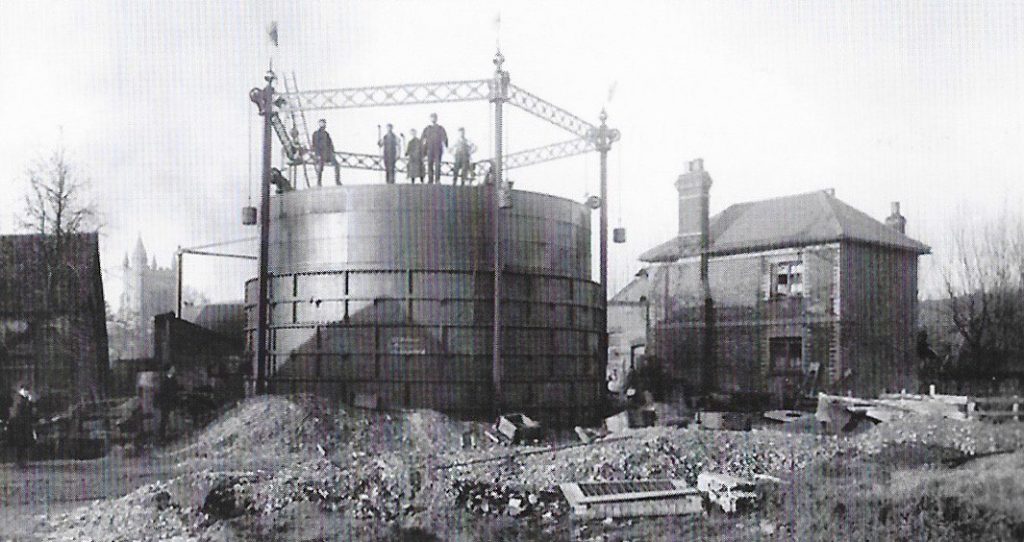
In relation to the development of the old Griffin Hotel as an ASK pizza restaurant, it was as a result of the Society’s discussions that the name remains in lettering above the portico and the history of the traditional inn is on display in the restaurant; however, it is very sad that the original sign and the notice saying ‘Oliver Cromwell dined here’ were lost during the refurbishment, despite the many representations by the Society.
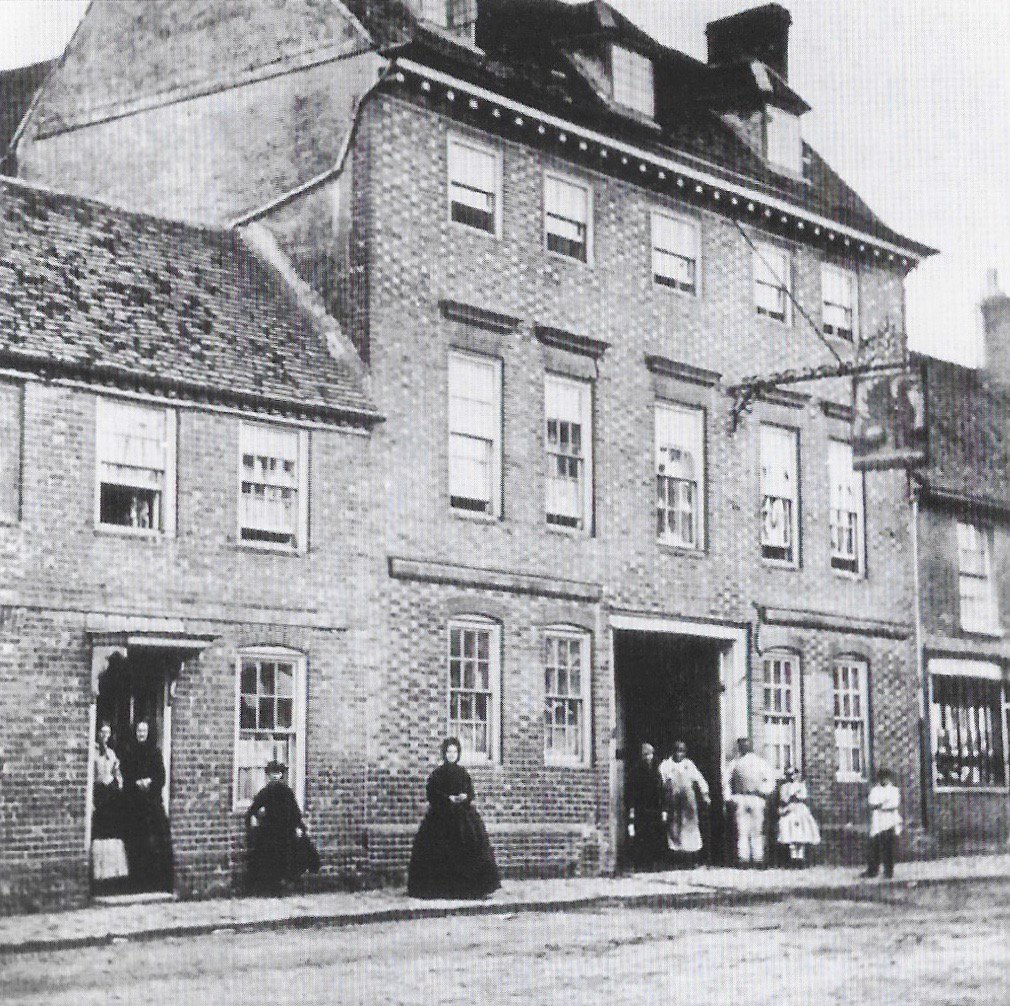
The Millenium Year saw at last the improvement of the footpath and fencing beside the Misbourne, again at the end of a long campaign by members to remove the unsightly metal fence erected for safety reasons; the reduction in the water flow as a result of over-extraction upstream has also been pursued with some success.
Monitoring planning activities
The Society has always sought to examine planning issues, from individual applications to the reasoned review of major planning exercises locally and nationally. The major issues have been responded to in conjunction with ANTAS the Association of North Thames Amenity Societies, to which the Society has been affiliated since its inception; this has enabled a stronger voice to be heard and provided an opportunity to work with groups of experts willing to advise on planning matters. Most recently, the Bucks County Council’s paper ‘Shaping the Future’, sought views on alternatives to meet the target of nearly 20,000 homes in Buckinghamshire in the next 15 years, including encroachment into Green Belt land, contrary to previous policy. Our members have enjoyed a talk by Gill Gowing, the Director of Planning and the Environment for Chiltern District Council, keeping them informed about the Government’s plans to change the planning system.
At each Committee meeting, members review the summary of planning applications examined by the Sub-Committee and comment on their likely effect on the Old Town and its environment. Our policy has always been not to be known as a Society which objects to all change, but to review applications in the light of the Council’s own Plans (which the Council itself sometimes fails to do). Our aim is always to maintain the integrity and character of the Old Town and to ensure that dilapidated properties are developed sympathetically rather than allowed to deteriorate.
We have, we think not unreasonably, sought to prevent the addition of mobile phone masts, overdevelopment of small plots, unsightly extensions and buildings which are out of keeping with their surroundings. Unfortunately, the extension of the Museum has not been universally acclaimed by members, but it is felt that the new building is indeed weathering with time and melding happily with its neighbours.
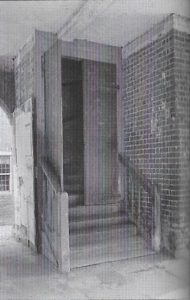
One issue which has been substantially influenced by the Society has been the development of the hospital site, resulting in a significant reduction in the height of the flats and a much less dominant and obtrusive building overall. However, it has, as anticipated, brought additional traffic into the town and the need for improved parking is still unresolved.
Caring for the environment
Particularly important has been the observance and reporting of changes in the Town by Society members, allowing the Society to investigate whether these have the appropriate planning approval. It is worth mentioning that objections to unapproved developments on the Platt, inappropriate development of farm buildings and the development of the Famous Fish restaurant have been initiated by members; members continue to be vigilant in seeing that the Misbourne is kept clear of debris and litter, especially in the Tesco environs. Items of concern to a few members are not neglected, such as the removal of the unsightly urn behind the Crown Hotel, the obstruction of the footpath by planted troughs outside the Kings Arms and the littering of cigarette stubs outside the offices.
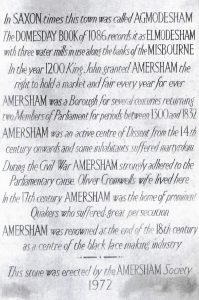
Our members continue to draw our attention to the difficulty of access to meetings by the steep winding steps of the Market Hall, and we are pressing the Town Council to seek a solution in the near future. Whilst we understand that a stair lift is not feasible, and that English Heritage would need to approve changes to the building, similar listed buildings have handled the provision for disabled access in similar situations sympathetically, albeit at considerable cost. A new submission is planned with the support of the Revitalisation Committee, a joint committee of the Society, the Town Council and the Old Town Business Association.
We have been keen to ensure that the signs and monuments in the Old Town are well cared for; we have ensured that the Vagrants Notice on the Broadway is legible and kept in good condition. The Society has maintained the signs on the Market Hall, instigating the repair of the plasterwork on the sign over the old gaol ‘Commit no nuisance’ and the stone plaque on the north wall, which gives the history of Amersham from Saxon times.
